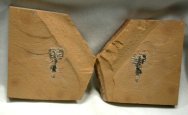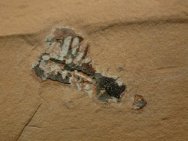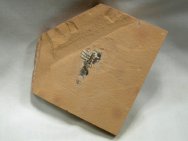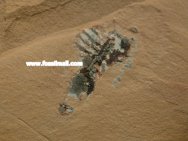 Description:
This is most of the thorax of the “Terror Of The Cambrian”,
Anomalocaris saron, seen here in the first example I have had. The
members of this group of enigmatic creatures are known from Asia,
Australia, Europe, and North America, and are thought by many to
be closely allied with the Arthropda, a position not held by all
researchers. Several have been described from Utah, notably a 50
mm partial specimen of A nathorsti from the Marjum Formation, but
they are far more rare Description:
This is most of the thorax of the “Terror Of The Cambrian”,
Anomalocaris saron, seen here in the first example I have had. The
members of this group of enigmatic creatures are known from Asia,
Australia, Europe, and North America, and are thought by many to
be closely allied with the Arthropda, a position not held by all
researchers. Several have been described from Utah, notably a 50
mm partial specimen of A nathorsti from the Marjum Formation, but
they are far more rare 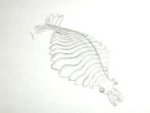 than those from Chengjiang or the Burgess
Shale. The central gut trace is present, as well as indications
of the lateral lobes. This is the first example I have had, and
I do not expect it will remain posted for long. than those from Chengjiang or the Burgess
Shale. The central gut trace is present, as well as indications
of the lateral lobes. This is the first example I have had, and
I do not expect it will remain posted for long.
The
House Range of Utah has several formations that exhibit Burgess
Shale-like preservation
of soft tissues, and yield fossils of creatures closely allied
with the Burgess Shale biota. Interestingly, the formations are
normally
found in alternating biofacies. Some are rich in trilobites lacking
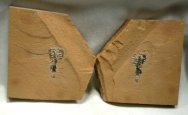 soft bodied organisms, while adjacent ones lack trilobites but preserve
soft bodied organisms in the form of kerogenized carbon films. Gaines
(2004) has studied the taphonomy of House Range soft tissue preservation,
hypothesizing a taphonomic pathway much like the Burgess Shale with
delayed decay facilitating rapid diagenesis in an anoxic zone lacking
benthic bioturbators. While soft bodied organisms are far rarer
and generally not so exquisitely preserved as in the Burgess Shale,
some scientists believe the House Range biota might be even more
diverse. Many fossils found are enigmatic as to their taxonomic
placement. Unfortunately, the numerous sites are much understudied,
while mining operations are resulting in wholesale destruction of
a potentially rich portion of the Cambrian fossil record. soft bodied organisms, while adjacent ones lack trilobites but preserve
soft bodied organisms in the form of kerogenized carbon films. Gaines
(2004) has studied the taphonomy of House Range soft tissue preservation,
hypothesizing a taphonomic pathway much like the Burgess Shale with
delayed decay facilitating rapid diagenesis in an anoxic zone lacking
benthic bioturbators. While soft bodied organisms are far rarer
and generally not so exquisitely preserved as in the Burgess Shale,
some scientists believe the House Range biota might be even more
diverse. Many fossils found are enigmatic as to their taxonomic
placement. Unfortunately, the numerous sites are much understudied,
while mining operations are resulting in wholesale destruction of
a potentially rich portion of the Cambrian fossil record.
References:
- Briggs
D.E.G., and R.A. Robison. 1984. Exceptionally preserved non trilobite
arthropods and Anomalocaris from the Middle Cambrian of Utah.
University of Kansas Paleontological Contributions, Paper 111:1-24.
- Gaines,
Robert R.; Kennedy, Martin J. Droser, Mary L. 2004. A new hypothesis
for organic preservation of Burgess Shale taxa in the middle Cambrian
Wheeler Formation, House Range, Utah. Palaeo, 220:193-205.
- House
Range Fossils: Wheeler Shale, Marjum Formation, and Weeks Formation,
The Virtual Fossil Museum (www.fossilmuseum.net).
Also
see a putative Anomalocaris
nathorsti Fossil from the older Wheeler Formation. |



